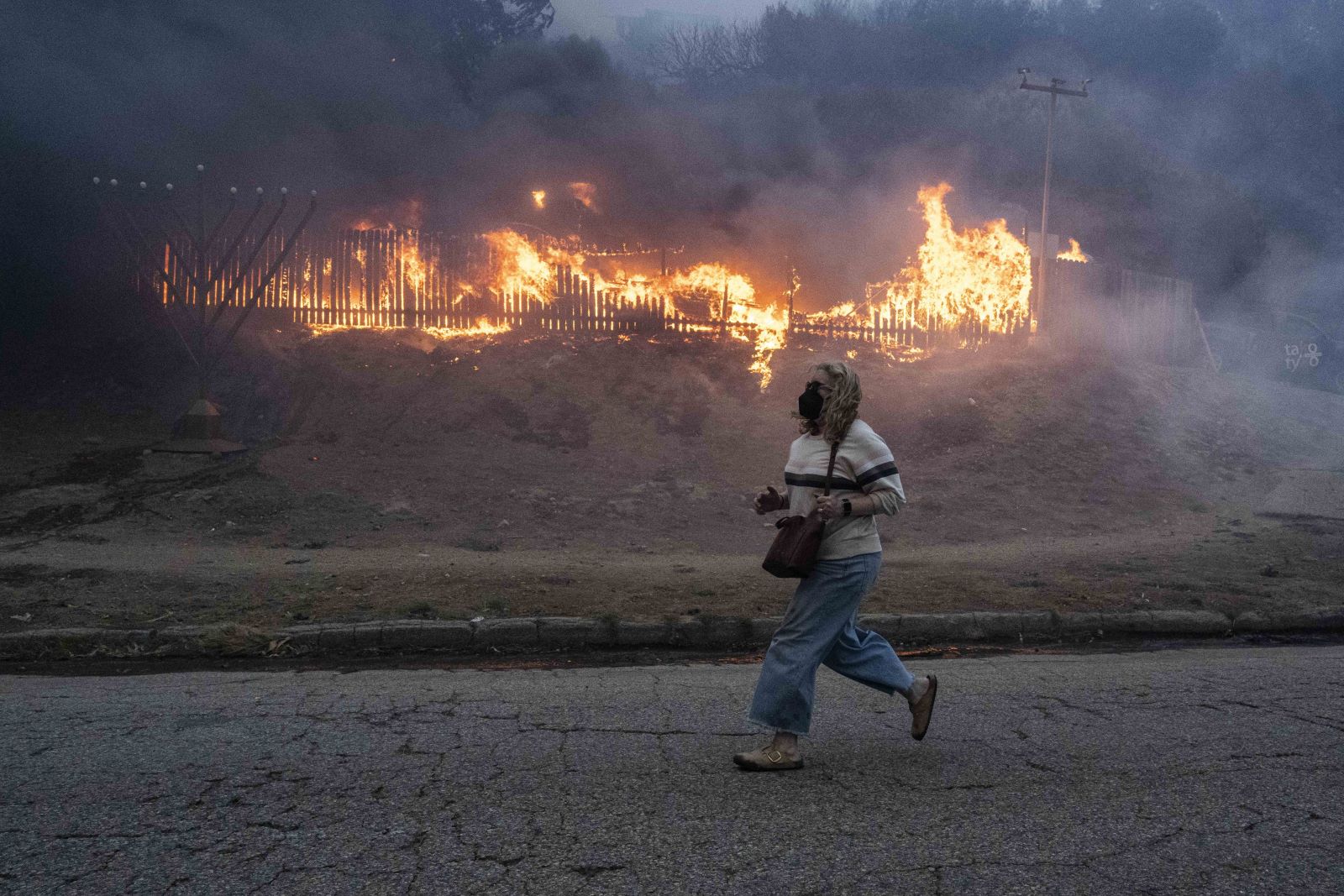Harel Dor and Finn O’Brien were just finishing up dinner at a restaurant in Pasadena, California, on Tuesday evening, when a friend texted them about an evacuation warning. A severe windstorm had spread what became the Eaton fire to the hills behind their home.
“Driving back up the house it was already feeling apocalyptic, with downed trees and visibility getting worse,” Dor said. As the couple returned to the house to evacuate their two cats, they could see the flames in the distance. Dor, who works nearby at NASA’s Jet Propulsion Laboratory, says while some co-workers have lost their homes, they don’t know if their apartment has survived the blaze.
“The emotions haven’t arrived yet,” Dor said. “A lot of it is just numbness and shock at the events unfolding.”
The hills around Los Angeles have become an inferno. Days after forecasters warned of dangerous fire weather conditions, twin blazes — driven by 100 mph winds — began raging across some of Southern California’s most expensive neighborhoods, sending thousands of residents fleeing and threatening historic sites. Within five hours on Wednesday morning, both the Palisades Fire east of Santa Monica and the Eaton Fire across Pasadena exploded from 2,000 acres to over 10,000. So far, two people have been confirmed dead and more than 1,000 structures have burned, potentially making the Palisades Fire one of the country’s most destructive.
“I do expect it is plausible that the Palisades Fire in particular will become the costliest on record, period,” said Daniel Swain, a climate scientist at the University of California, Los Angeles, during a live stream on Wednesday morning. That’s partly due to “the fact that some of those structures are some of the most expensive homes and buildings in the world.”
The fires have both immediate and underlying causes. The first ingredient for making such monstrous wildfires is the fuel. In the previous two years, some parts of coastal Southern California experienced their two wettest winters on record, spurring the growth of grass and brush. But now the region has had its driest start of winter on record, which parched that vegetation. The chaparral landscape turned into abundant tinder just waiting to burn.
“Under conditions of climate change, we will have wetter wet periods, very wet wet periods, and very dry dry periods,” said Stephanie Pincetl, director of the California Center for Sustainable Communities at UCLA. “The climatic conditions that Southern California has experienced over centuries are simply going to be exacerbated.”
The second ingredient is the spark. It will take some time for investigators to determine what set off all these blazes, but where humans tread, wildfires start. It could be a wayward firework, or a chain dragging off the back of a truck on the highway, or arson. California also has a major problem with its electric equipment jostling in the wind, showering sparks into the vegetation below. As winds kicked up on Tuesday, utilities like Southern California Edison shut off power to areas of the city in an effort to prevent just such an event.

Jon Putman/Anadolu via Getty Images
The third ingredient was high winds. This is Southern California’s prime season for Santa Ana winds, which form in the interior of the western United States. As that warm, dry air moves toward the sea, it drops down mountains, picking up speed. Scientists don’t expect climate change to boost the speed of these Santa Ana winds, though they may get drier and hotter. “They can dry vegetation even more,” said Alexander Gershunov, a research meteorologist at the Scripps Institution of Oceanography. “The same slopes that get a lot of precipitation from atmospheric rivers also get the strong Santa Ana winds.”
So there’s more fuel in those places, and unfortunately more of the wind that drives catastrophic fires. Once there’s a spark, the winds shove the fire forward with oftentimes inescapable speed. That’s how the Camp Fire killed 85 people in 2018, as the flames raced through the town of Paradise, trapping people in homes and cars. And that’s why authorities are fearing for the worst for these new, fast-moving Los Angeles fires.
“The spread has been quite dramatic. The Eaton fire especially,” said Devin Black, a meteorologist for the National Weather Service. Because the winds are moving erratically, he said, the public should be cautious when driving around the flames. “They can move very quickly, and you might get trapped,” he said.
Wind-driven wildfires are also notoriously difficult to fight, and not just because they move so fast. Those Santa Ana winds are blowing embers ahead of the main wall of the fire, lighting new fires perhaps a mile ahead. So a large, intense fire can spawn smaller blazes that themselves burn out of control, as crews are already stretched thin across the landscape. In Los Angeles county on Wednesday afternoon, four separate fires were taxing the firefighting response, with some fire hydrants running dry. None of them were contained, according to the California Department of Forestry and Fire Protection. Part of the problem is that winds grounded the aircraft used to drop water.
The immediate emergency is containing the blazes and getting people to safety. The longer-term challenge is better adapting Los Angeles, and the rest of California, to a future of ever-worsening droughts and wildfires. “People talk about adapting to the climate,” Pincetl said. “We haven’t adapted to the climate we have, let alone the climate that’s coming.”

